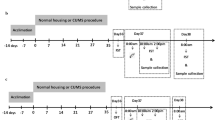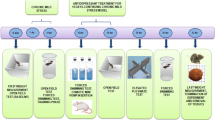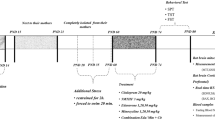Abstract
Major depressive disorder (MDD) is an important health problem that is often associated to stress. One of the main brain regions related to MDD is the ventral tegmental area (VTA), a dopaminergic center, part of the reward and motivation circuitry. Recent studies show that changes to VTA dopaminergic neurons are associated with depression and treatment. Ketamine has recently shown a fast, potent antidepressant effect in acute, sub-anesthetic doses. Thus, our aims were to elucidate if ketamine would be able to revert depression-like behaviors induced by a chronic unpredictable stress (CUS) protocol and if it could cause alterations to metabolism and tyrosine hydroxylase (TH)-immunoreactivity in VTA. For this, 48 Wistar rats were divided into four groups: control + saline (CTRL + SAL), control + ketamine (CTRL + KET), CUS + saline (CUS + SAL), CUS + ketamine (CUS + KET). The CUS groups underwent 28 days of CUS protocol. Saline or ketamine (10 mg/kg) was administered intraperitonially once on day 28. The behavior was assessed by the sucrose preference test, the open field test, and the forced swim test. Glucose brain metabolism was assessed and quantified with microPET. TH-immunoreactivity was assessed by estimating neuronal density and regional and cellular optical densities. A decrease in sucrose intake in the CUS groups and an increase in immobility was rapidly reverted by ketamine (p < 0.05). No difference was observed in the open field test. There was no alteration to VTA metabolism and TH-immunoreaction. These results suggest that the depressive-like behavior induced by CUS and the antidepressant effects of ketamine are unrelated to changes in neuronal metabolism or dopamine production in VTA.






Similar content being viewed by others
References
Agmo A, Galvan A, Talamentes B (1995) Reward and reinforcement produced by drinking sucrose: two processes that may depend on different neurotransmitters. Pharmacol Biochem Behav 52:403–414
Ahmad A, Rasheed N, Banu N, Palit G (2010) Alterations in monoamine levels and oxidative systems in frontal cortex, striatum, and hippocampus of the rat brain during chronic unpredictable stress. Stress 13:355–364
American Psychiatry Association (2014) Diagnostic and statistical manual of mental disorders: DSM-5, 1st edn. American Psychiatry Association, Washington
Bagatini PB, Xavier LL et al (2014) Resveratrol prevents akinesia and restores neuronal tyrosine hydroxylase immunoreactivity in the substancia nigra pars compact of diabetic rats. Brain Res 1592:101–112
Banasr M, Valentine GW, Li X, Gourley SL, Taylor JR, Duman RS (2007) Chronic unpredictable stress decreases cell proliferation in the cerebral cortex of the adult rat. Biol Psychiatry 62:496–504
Berman RM, Cappiello A et al (2000) Antidepressant effects of ketamine in depressed patients. Biol Psychiatry 47(4):351–354
Bhutani MK, Bishnoi M, Kulkarni SK (2009) Anti-depressant like effect of curcumin and its combination with piperine in unpredictable chronic stress-induce behavioral, biochemical and neurochemical chages. Pharmacol Biochem Behav 92:39–43
Blood AJ, Iosifescu DV, Makris N, Perlis RH, Kennedy DN (2010) Microstuctural abnormalities in subcortical reward circuitry of subjects with major depressive disorder. PLoS One 5(11):e13945
Browne CA, Lucki I (2013) Antidepressant effects of ketamine: mechanisms underlying fast-acting novel antidepressants. Front Pharmacol 4:1–18
Burgdorf J, Zhang X, Nicholson K et al (2013) GLYX-13, a NMDA receptor glycine-site functional partial agonist, induces antidepressant-like effects without ketamine-like side effects. Neuropsychopharmacology 38:729–742
Cryan JF, Page ME, Lucki I (2005) Different behavioral effects of the antidepressants reboxetine, fluoxetine, and moclobemide in a modified forced swim test following chronic treatment. Psychopharmacology 182:335–344
Czéh B, Simon M, Schmelting M, Hiemke C, Fuchs E (2006) Astroglial plasticity in the hippocampus of affected by chronic psychosocial stress and concomitant fluoxetine treatment. Neuropharmacology 31:1616–1626
Dang H, Chen Y et al (2009) Antidepressant effects of gingseng total saponins in the forced swimming test and chronic mild stress models of depression. Prog Neuro-Psychopharmacol Biol Psychiatry 33:1417–1424
Diazgranados N, Ibrahim L et al (2010) A randomized add-on trial of an N-methyl-D-aspartate antagonist in treatment-resistant bipolar depression. Arch Gen Psychiatry 67(8):793–802
Dunlop BW, Nemeroff CB (2007) The role of dopamine in the pathophysiology of depression. Arch Gen Psychiatry 64:327–337
Eisenstein SA, Clapper JR, Holmes PV, Piomelli D, Hohmann AG (2010) A role for 2-arachidonoyglycerol and endocannabinoid signaling in the locomotor response to novelty induced by olfactory bulbectomy. Pharmacol Res 61:419–429
Ferrari AJ, Charlson FJ et al (2013) Burden of depressive disorders by country, sex, age, and year: findings from the global burden of disease study 2010. PLoS Med 10(11):e1001547
Ferraz AC, Matheussi F et al (2008) Evaluation of estrogen neuroprotective effect on nigrostriatal dopaminergic neurons following 6-hydroxydopamine injection into the substancia nigra pars compacta or the medial forebrain bundle. Neurochem Res 33:1238–1246
Friedman AK, Walsh JJ et al (2014) Enhancing depression mechanisms in midbrain dopamine neurons achieves homeostatic resilience. Science 344:313–319
Gunaydin LA, Grosenick L et al (2014) Natural neural projection dynamics underlying social behavior. Cell 157:1535–1551
Hill MN, Hellemans KGC, Verma P, Gorzalka BB, Weinberg J (2012) Neurobiology of chronic mild stress: parallels to major depression. Neurosci Biobehav Rev 36:2085–2117
Hnasko TS, Chuhma N et al (2010) Vesicular glutamate transport promotes dopamine storage and glutamate corelease in vivo. Neuron 65:643–656
Hu H, Su L, Xu YQ, Zhang H, Wang LW (2010) Behavioral and [F-18] fluorodeoxyglucose micro positron emission tomography imaging study in a rat chronic mild stress model of depression. Neuroscience 169:171–181
Huynh TN, Krigbaum AM, Hanna JJ, Conrad CD (2011) Sex difference and phase of light cycle modify chronic stress effects on anxiety and depressive-like behavior. Behav Brain Res 222:212–222
Itoi K, Sugimoto N (2010) The brainstem noradrenergic systems in stress, anxiety and depression. J Neuroendocrinol 22:355–361
Johnson BN, Yamamoto BK (2009) Chronic unpredictable stress augments +3,4-methylenedioxymethamphetamine-induced monoamine depletions: the role of corticosterone. Neuroscience 159:1233–1243
Krishnan V, Nestler EJ (2008) The molecular neurobiology of depression. Nature 455:894–902
Kristal JH, Sanacora G, Duman RS (2013) Rapid-actin glutamatergic antidepressant: the path to ketamine and beyond. Biol Psychiatry 73:1133–1141
Lammel S, Lim BK, Malenka RC (2014) Reward and aversion in a heterogeneous midbrain dopamine system. Neuropharmacology 76:351–359
Lang UE, Borgwardt S (2013) Molecular mechanisms of depression: perspectives on new treatment strategies. Cell Physiol Biochem 31:761–777
Li N, Lee B et al (2010) mTOR-dependent synapse formation underlies the rapid antidepressant effects of NMDA antagonists. Science 329:959–964
Lin Z, Shi L et al (2013) Effects of curcumin on glucose metabolism in the brains of rats subjected to chronic unpredictable stress: a 18F-FDG micro-PET study. BMC Complem Alt Med 13:202
Luckenbaugh DA, Niciu MJ et al (2014) Do the dissociative side effects of ketamine mediate its antidepressant effects? J Affect Disord 159:56–61
Ma X, Jiang D et al (2011) Social isolation-induced aggression potentiates anxiety and depressive-like behavior in male mice subjected to unpredictable chronic mild stress. PLoS One 6(6):e20955
Ma XC, Dang YH, Jia M et al (2013) Long-lasting antidepressant action of ketamine, but noy glucogen synthase kinase-3 inhibitor SB216763, in the chronic mild stress model of mice. PLoS One 8:e56053
Machado-Vieira R, Manji HK, Zarate CA (2009) The role of the tripartite glutamatergic synapse in the pathophysiology and therapeutics of mood disorders. Neuroscientist 15:525–539
Maeng S, Zarate CA Jr, Du J et al (2008) Cellular mechanisms underlying the antidepressant effects of ketamine: role of alpha-amino-3-hydroxy-5-methylisoxazole-4-propionic acid receptors. Biol Psychiatry 63:349–352
Matuszewich L, Karney JJ, Carter SR, Janasik SP, O’Brien JL, Friedman RD (2007) The delayed effects of chronic unpredictable stress on anxiety measures. Physiol Behav 90:674–681
Moghaddam B, Adams B, Verma A, Daly D (1997) Activation of glutamatergic neurotransmission by ketamine: a novel step in the pathway from NMDA receptor blockade to dopaminergic and cognitive disruptions associated with the prefrontal cortex. J Neurosci 17:2921–2927
Morales M, Root DH (2014) Glutamate neurons within the midbrain dopamine regions. Neuroscience 282:60–68
Murrough J, Charney DS (2011) Lifting the mood with ketamine. Nat Med 16(12):1384–1385
Murrough JW, Iosifescu DV et al (2013) Antidepressant efficacy of ketamine in treatment-resistant major depression: a two-site randomized controlled trial. Am J Psychiatry 170(10):1134–1142
do Nascimento PS, Lovatel GA et al (2011) Treadmill training improves motor skills and increases tyrosine hydroxylase immunoreactivity in the substancia nigra pars compacta in diabetic rats. Brain Res 1382:173–180
Naughton M, Clarke G, O’Leary OF, Cryan JF, Dinan TG (2014) A review of ketamine in affective disorders: current evidence of clinical efficacy, limitations and use and pre-clinical evidence on proposed mechanism of action. J Affect Disord 156:24–35
Olfson M, Marcus SC, Shaffer D (2006) Antidepressant drug therapy and suicide in severely depressed children and adults. Arch Gen Psychiatry 63:865–872
Ortiz J, Fitzgerald LW, Lane S, Terwillinger R, Nestler EJ (1996) Biochemical adaptations in the mesolimbic dopamine system in response to repeated stress. Neuropsychopharmacology 14:443–452
Otte D-M, Barcena de Arellano ML et al (2013) Effects of chronic d-serine elevation on animal models of depression and anxiety-related behavior. PLoS One 8(6):e67131
Polter AM, Kauer JA (2014) Stress and VTA synapses: implications for addiction and depression. Eur J Neurosci 39:1179–1188
Price RB, Nock MK, Charney DS, Mathew SJ (2009) Effects of intravenous ketamine on explicit and implicit measures of suicidality in treatment-resistant depression. Biol Psychiatry 66:522–526
Quan M, Zhang N, Wang Y, Zhang T, Yang Z (2011) Possible antidepressant effects and mechanisms of memantine in behaviors and synaptic plasticity of a depression rat model. Neuroscience 182:88–97
Rasheed N, Ahmad A, Pandey CP, Chatuverdi RK, Lohani M, Palit G (2010) Differential response of central dopaminergic system in acute and chronic unpredictable stress model in rats. Neurochem Res 35:22–32
Rasheed N, Tyagi E, Ahmad A, Siripurapu KB, Lahiri S, Shukla R, Palit G (2008) Involvement of monoamines and proinflammatory cytokines in mediating the anti-stress effects of Panax quinquefolium. J Ethnopharmacol 117:257–262
Razafsha M, Behforuzi H et al (2013) An updated overview of animal models in neuropsychiatry. Neuroscience 240:204–218
Rizelio V, Szawka RE et al (2010) Lesion of the subthalamic nucleus reverses motor deficits but not death of nigrostriatal dopaminergic neuronsin a rat 6-hydroxydopamine-lesion model of Parkinson’s disease. Braz J Med Biol Res 43(1):85–95
Rong H, Wang G, Liu T, Wang H, Wan Q, Weng S (2010) Chronic mild stress induces fluoxetine-reversible decreases in hippocampal and cerebrospinal fluid levels of the neurotrophic factor S100B and its specific receptor. Int J Mol Sci 11:5310–5322
Saur L, Baptista PPA et al (2014) Physical exercise increases GFAP expression and induces morphological changes in hippocampal astrocytes. Brain Struct Funct 219:293–302
Slattery DA, Cryan JF (2012) Using the rat forced swim test to assess antidepressant-like activity in rodents. Nat Protoc 7(6):1009–1014
Schiffer WK, Mirrione MM et al (2006) Serial microPET measures of the metabolic reaction to a microdialysis probe implat. J Neurosci Methods 155:272–284
Su X, Cheng K (2014). Comparison of two site-specifically 18F-labelled affibodies for PET imaging of EGFR positive tumors. Mol Pharm 11(11):3947–3956
Tata DA, Yamamoto BK (2008) Chronic stress enhances methamphetamine-induced extracellular glutamate and excitotoxicity in the rat striatum. Synapse 62:325–336
Tye KM, Mirzabekov JJ et al (2013) Dopamine neurons modulate neural encoding and expression of depression-related behavior. Nature 493:537–541
Uher R, Payne JL, Pavlova B, Perlis RH (2014) Major depressive disorder in DSM-5: implications for clinical practice and research of changes from DSM-IV. Depress Anxiety 31:459–471
Venzala E, García-García AL, Elizalde N, Tordera RM (2013) Social vs. environmental stress model of depression from a behavioural and neurochemical approach. Eur Neuropsychopharmacol 23:697–708
WHO (2012) Depression: a global crisis. World Federation for Mental Health, Occoquan, VA
Willner P (2005) Chronic mild stress (CMS) revisited: consistency and behavioural-neurobiological concordance in the effects of CMS. Neuropsychobiology 52:90–110
Willner P, Scheel-Kruger J, Belzung C (2013) The neurobiology of depression and antidepressant action. Neurosci Biobehav Rev 37:2331–2371
Winter C, von Rumohr A et al (2007) Lesions of dopaminergic neurons in the substancia nigra pars compacta and in the ventral tegmental area enhance depressive-like behavior in rats. Behav Brain Res 184:133–141
Wyckhuys T, Wyffels L, Langlois X, Schmidt M, Stroobants S, Staelens S (2014) The [18F] FDG µPET readout of a brain activation model to evaluate the metabotropic glutamate receptor 2 positive allosteric modulator JNJ-42153605. J Pharmacol Exp Ther 350(2):375–386
Xavier LL, Viola GG et al (2005) A simple and fast densitometric method for the analysis of tyrosine hydroxylase immunoreactivity in the substancia nigra pars compacta and in the ventral tegmental area. Brain Res Protoc 16:58–64
Yang C, Li X, Wang N et al (2012) Tramadol reinforces antidepressant effects of ketamine with increased levels of brain-derived neurotrophic factor and tropomyosin-related kinase B in rat hippocampus. Front Med 6:411–415
Yang C, Hu YM, Zhou ZQ et al (2013) Acute administration of ketamine in rats increases hippocampal BDNF and mTOR levels during forced swimming test. Ups J Med Sci 118:3–8
Yi LT, Li JM, Li YC, Pan Y, Xu Q, Kong LD (2008) Antidepressant-like behavioral and neurochemical effects of the citrus-associated chemical apigenin. Life Sci 82:741–751
Zarate CA Jr, Singh JB et al (2006) A randomized trial of N-methyl-D-aspartate antagonist in treatment-resistant major depression. Arch Gen Psychiatry 63(8):856–864
Zhong P, Liu X et al (2014) Cyclin-dependent kinase 5 in the ventral tegmental area regulates depression-related behaviors. J Neurosci 34(18):6352–6366
Zhu MY, Klimek V et al (1999) Elevated levels of tyrosine hydroxylase in the locus coeruleus in major depression. Biol Psychiatry 46(9):1275–1286
Acknowledgments
The authors would like to thank the Brazilian funding agencies CNPq, CAPES, and FAPERGS for their support of this research. Dr. Diogo Lara, Dr. Jaderson Costa daCosta, and Dr. Léder Xavier are CNPq researchers.
Conflict of interest
The authors declare they have no conflicts of interest.
Author information
Authors and Affiliations
Corresponding author
Rights and permissions
About this article
Cite this article
Baptista, P.P.A., Saur, L., Bagatini, P.B. et al. Antidepressant Effects of Ketamine Are Not Related to 18F-FDG Metabolism or Tyrosine Hydroxylase Immunoreactivity in the Ventral Tegmental Area of Wistar Rats. Neurochem Res 40, 1153–1164 (2015). https://doi.org/10.1007/s11064-015-1576-3
Received:
Revised:
Accepted:
Published:
Issue Date:
DOI: https://doi.org/10.1007/s11064-015-1576-3




